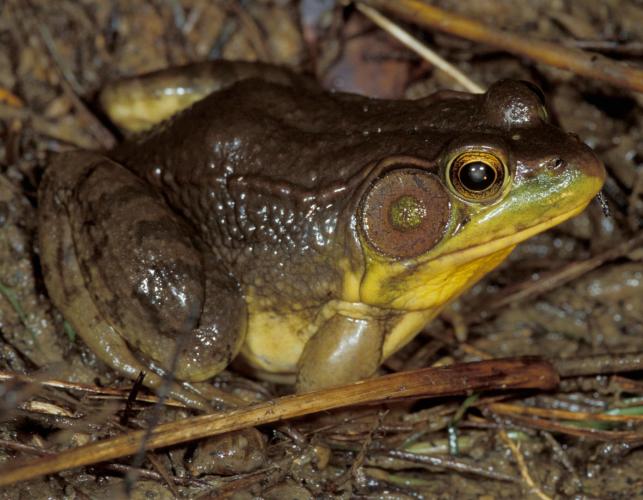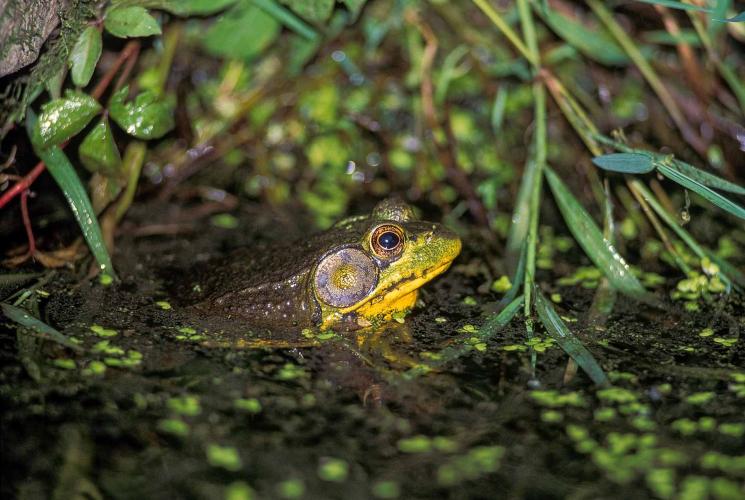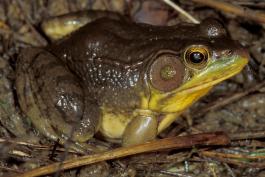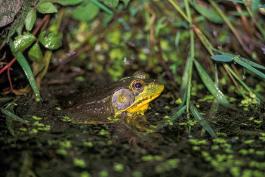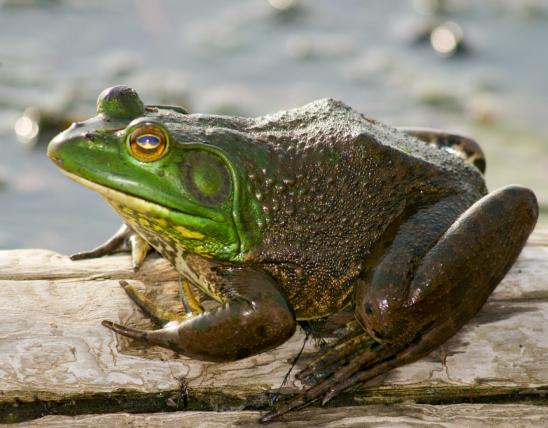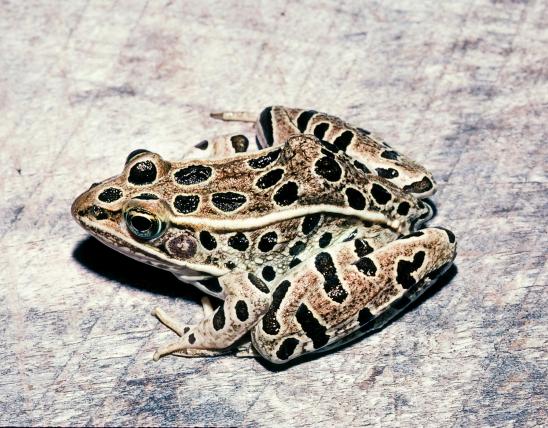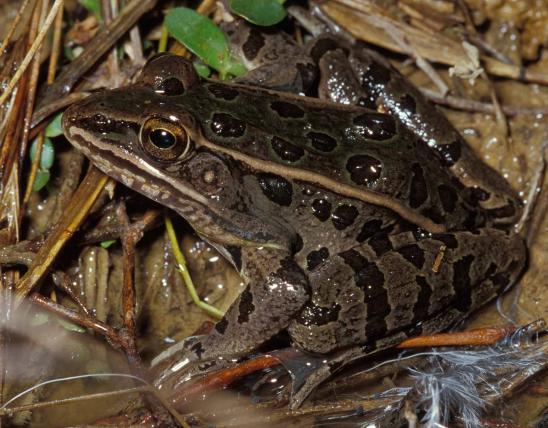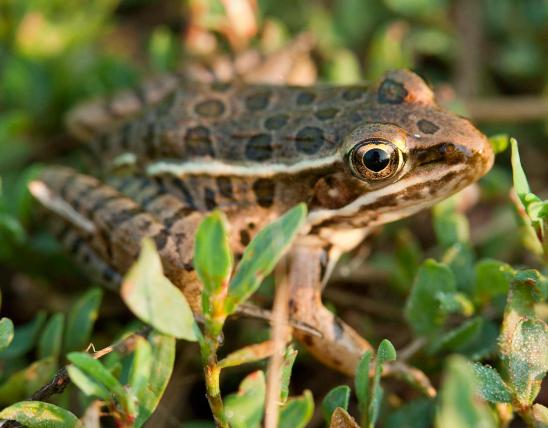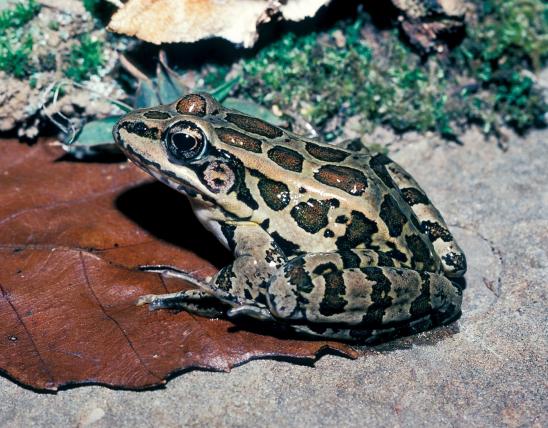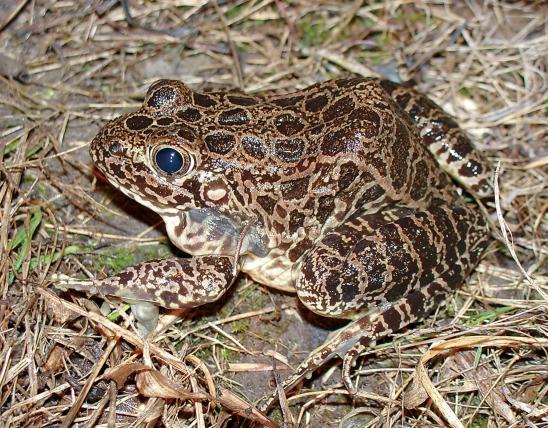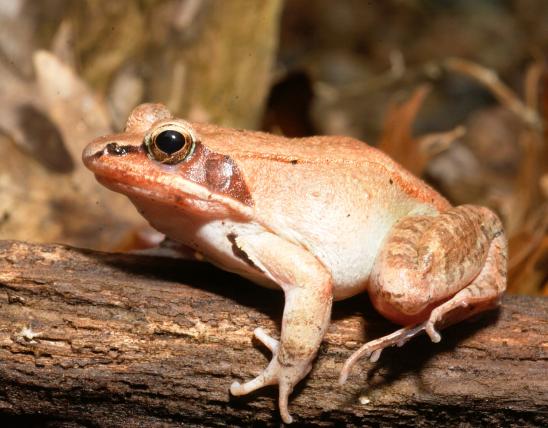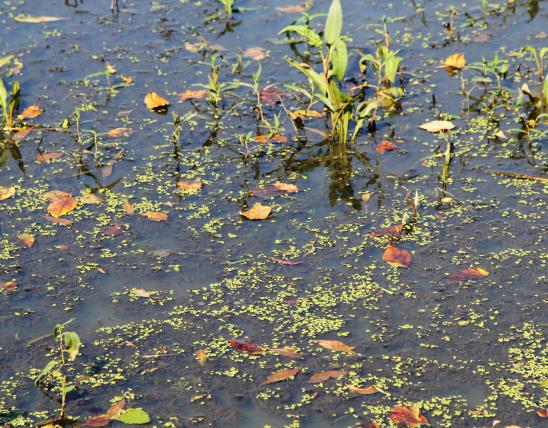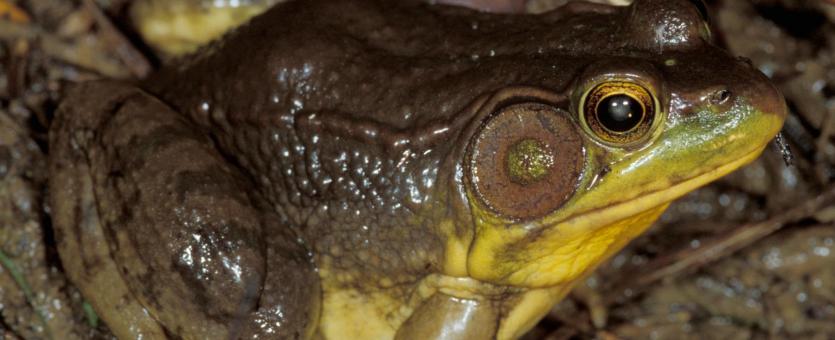
The green frog is a medium-sized frog whose general color is green to greenish tan to brown, with the upper lip and head usually green. There may be faint dark spots on the back, and the legs usually have indistinct dark spots or bars. The sides of the belly often are marked with fine, irregular, dark gray lines. The belly is white with some dusky markings. Adult males have a bright yellow throat.
There is a distinct dorsolateral fold (a ridge of skin along the sides of the back); this fold extends only to the middle of the body, not all the way to the groin. The external eardrum (tympanum) is large and conspicuous; in males, it is larger than the eye.
The call of males is an explosive “bong” that sounds like a loose banjo string. The sound may be emitted once or repeated three or four times.
Two subspecies were formerly recognized for Lithobates clamitans: the green frog (L. clamitans melanota) and the bronze frog (L. clamitans clamitans). Genetic analysis does not support formal separation of the two subspecies but it affirms that there are two distinct color phases. The northern color phase is generally green to olive, while the southern color phase is more brown to bronze. The green color phase is found throughout most of Missouri except for the southeastern portion, where the bronze phase typically occurs.
Similar species: The green frog looks similar to the American bullfrog but is smaller and has a ridge of skin along the sides of the back, from behind the eye to midbody, that is not found on bullfrogs.
Missouri has eight members of the true frog family. These are typically medium to large frogs that have long legs, smooth skin, and well-developed webbing between the hind toes. Another common characteristic is a glandular fold or ridge of skin along each side of the back (these are called dorsolateral folds); of Missouri's true frogs, only the American bullfrog lacks these folds.
Adult length (snout to vent): usually 2 to 3 inches; occasionally to 4¼ inches.
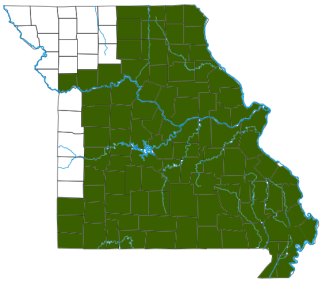
Occurs in about three-quarters of the state, mostly southeast of a diagonal line from the southwestern to northeastern corners of the state.
Habitat and Conservation
In Missouri, green frogs typically live in creeks and streams, especially in the Ozarks. Other habitats include river sloughs, swamps, marshes, and ponds. Some live in caves. Among human-built habitats, they may live in golf course ponds and landscape water gardens around homes.
When disturbed, a green frog quickly jumps into the water, often emitting a high-pitched squawk as it jumps.
Green frogs are rather solitary, especially in small stream habitats, where each deep pool may have a single adult in residence.
Green frogs typically overwinter in aquatic habitats; they prefer to shelter under large rocks or other debris in flowing streams that do not freeze and provide plenty of oxygen.
Green frogs in Missouri are mainly active between mid-March and mid-November, sometimes into early December if the autumn weather is mild.
Food
Green frogs presumably eat a variety of insects, snails, slugs, spiders, and small crayfish. A study of green frogs in southern Illinois showed them eating beetles, spiders, millipedes, snails, true bugs, and flies.
Status
The green frog is classified as a game species in Missouri and can only be harvested for food or live bait during a defined season with a bag limit. Consult the current Wildlife Code of Missouri for regulations.
Taxonomy: The true frog family (Ranidae) is the largest and most widespread family of frogs. It contains 365 species in 14 genera and probably originated in Africa. Representatives of this cosmopolitan family occur on every major land mass except New Zealand, Antarctica, most oceanic islands, the West Indies, and southern South America. The largest genus in the family in the New World (North and South America) is Lithobates (formerly Rana), with about 50 species. Missouri’s species, formerly in genus Rana, are all in genus Lithobates. As of taxonomic understandings in 2016, the Rana genus is considered restricted to the eastern hemisphere and western North America. In Missouri, the genus Lithobates is represented by eight species.
Life Cycle
Breeding choruses in Missouri occur from mid-April until mid-July, peaking in June. Adult green frogs migrate into breeding ponds April through October, with the peak from May to mid-June. Any permanent standing water can be used as a breeding site, including ponds, swamps, sloughs, beaver ponds, and slow-moving areas of rivers and streams. The choicest sites for calling males are ones with an abundance of emergent plants, and males compete intensively for these locations.
Females lay eggs in a wide, floating mass on the water surface. Each female can lay 4,000 eggs or more. Females are capable of laying more than one clutch of eggs during the breeding season. Tadpoles begin hatching within 3–5 days. Most do not transform into froglets until the following summer, though some tadpoles may transform the same summer as hatching.
Although green frogs have lived for 7–10 years in captivity, most individuals in the wild probably live 5–6 years.
Human Connections
Frogging is like a cross between hunting and fishing. Consult the Wildlife Code of Missouri for regulations. Frog legs have a mild flavor similar to that of fish. They can be battered and fried or sautéed in butter. They make a good base for Cajun dishes that call for fish or shellfish.
Ecosystem Connections
Frogs are predators that help keep populations of insects and other small animals in balance. They, and especially their eggs, tadpoles, and young froglets, become food for both aquatic and terrestrial predators ranging from water bugs to fish to grackles to raccoons.
Adult green frogs will change their behavior when bullfrogs are present by selecting breeding sites away from the more aggressive bullfrogs.
